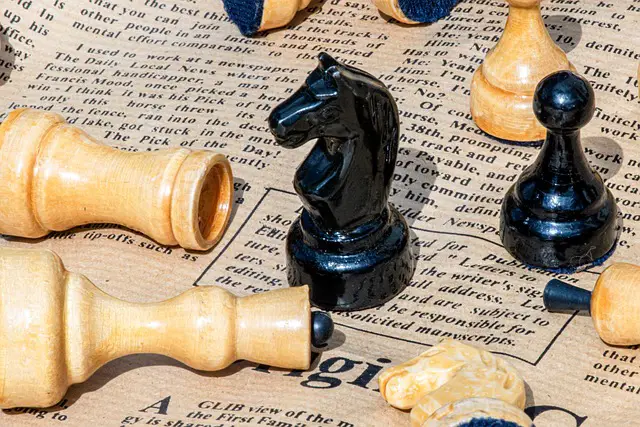Chess, the ancient game of kings and queens, unfolds on its 64-square battlefield, revealing a captivating maxim that transcends mere moves and captures the essence of strategic brilliance: “A Knight on f5 is Worth a Pawn.”
In the rhythmic dance of chess pieces, this seemingly straightforward statement conceals a profound strategic depth, where the sacrifice of a pawn paves the way for the majestic knight to dominate the board.

Unveiling the chessboard landscape
Contents
- 1 Unveiling the chessboard landscape
- 2 The power unleashed: Knight on f5
- 3 Strategic considerations
- 4 Famous games and grandmaster strategies
- 5 Tactical patterns and maneuvers
- 6 Practical application
- 7 Challenges and counter-strategies
- 8 Chess endgames: From middlegame to endgame
- 9 Training exercises: Sharpening your Chess instincts
- 10 Conclusion
In the symphony of the chessboard, each piece plays a unique role. The knight, a cunning warrior capable of making L-shaped leaps, takes center stage in our exploration.
Amidst the 64 squares, the f5 square emerges as a strategic focal point, where a knight can exert maximum influence, creating waves that resonate across the board.

The strategic dance of the chessboard
Understanding the power of the knight on f5 requires grasping its influence on key squares. Unlike other pieces, the knight’s L-shaped movement allows it to strategically dominate positions that might be inaccessible to its counterparts.
Consider this: a knight on f5 controls critical squares on the board, limiting the opponent’s options and setting the stage for a tactical showdown. This control isn’t just about physical presence; it’s about dictating the tempo of the game, a strategic symphony orchestrated by the knight.
The power unleashed: Knight on f5
Controlling the board with finesse
Imagine a game where White sacrifices a pawn to place a knight on f5. The knight, perched on this coveted square, exerts unparalleled control over the board. By dominating key squares, the knight restricts the opponent’s pieces and limits their strategic options.
In the classic game between Bobby Fischer and Boris Spassky during the 1972 World Chess Championship, Fischer, playing as White, executed a brilliant sacrifice to place his knight on f5. The subsequent control over the board allowed Fischer to dictate the pace of the game, eventually leading to a memorable victory.
Attacking opportunities
The real magic happens when the knight on f5 sets its sights on the opponent’s king. The g7 square, weakened by the knight’s presence on f5, becomes a vulnerable point in the opponent’s defense. This sets the stage for a dynamic assault, where the sacrifice of a pawn becomes a strategic gambit.
Consider the game between Garry Kasparov and Anatoly Karpov in their 1985 World Championship match. Kasparov, playing as White, sacrificed a pawn to place his knight on f5, targeting Karpov’s exposed king. This bold strategy led to a tactical masterpiece and showcased the power of the knight on f5 in initiating a devastating attack.
Defensive capabilities
The knight on f5 isn’t merely an offensive powerhouse; its strategic influence extends to defensive capabilities. By guarding key squares and countering opponent advances, the knight becomes a dynamic force on the board.
In a game between Viswanathan Anand and Vladimir Kramnik, Anand, playing as Black, strategically maneuvered his knight to f5, thwarting Kramnik’s aggressive advances. The knight’s defensive prowess created a counterattacking opportunity, turning the tide of the game in Anand’s favor.

Strategic considerations
In the intricate dance of chess, sacrificing a pawn for a knight on f5 is a bold move that requires careful consideration. It’s not about immediate gains; it’s about positional advantage and long-term control of the board.
Imagine a game where a player sacrifices a pawn to place their knight on f5, disrupting the opponent’s plans and creating imbalances. This strategic approach, seen in countless grandmaster games, exemplifies the principle that in chess, not all sacrifices are losses.
Famous games and grandmaster strategies
Historical games
Delving into the pages of chess history reveals iconic battles where the knight on f5 played a starring role. In the 1959 game between Mikhail Tal and Mikhail Botvinnik, Tal, playing as Black, sacrificed a pawn to place his knight on f5. The ensuing tactical melee showcased the brilliance of the knight’s strategic positioning.
Analyzing strategies
Modern-day chess has witnessed grandmasters employing the “knight on f5” strategy with finesse. An analysis of games played by Magnus Carlsen, the reigning world champion, reveals instances where a well-timed sacrifice led to a dominating knight on f5, influencing the course of the game.
Tactical patterns and maneuvers
Forks and double attacks
The knight on f5, strategically positioned, becomes a tactical wizard capable of executing forks and double attacks. Picture this: the knight simultaneously threatening the opponent’s queen and rook, creating a symphony of tactical brilliance on the board.
Consider a game where a player, with a knight on f5, executed a dazzling fork, attacking both the opponent’s king and a critical piece. The ensuing tactical complications demonstrated the versatility and power of the knight on f5.

Open files and diagonals
The knight on f5, with its unique movement, can exploit open files and diagonals, penetrating deep into the opponent’s territory. This flexibility adds layers to its tactical repertoire, creating opportunities for unexpected breakthroughs.
In a memorable game between Levon Aronian and Hikaru Nakamura, Aronian, playing as White, strategically maneuvered his knight to f5, exploiting open diagonals and creating a lethal attack. The game showcased the dynamic possibilities that arise when the knight on f5 targets weaknesses in the opponent’s position.
Practical application
Chess is a game played on the board, and the “knight on f5” strategy is not confined to grandmaster games. Here’s how you can bring this maxim to life in your own games.
Tips for every chess enthusiast
Train your eyes to recognize the opportune moment. Look for positions where sacrificing a pawn for the coveted f5 square can shift the tide in your favor. It’s about pattern recognition and seizing the right moments, as illustrated in a game where an amateur player strategically placed their knight on f5, turning the game in their favor.
Common mistakes to avoid: Pitfalls on the chessboard
Chess is a game of precision, and even a well-intentioned sacrifice can backfire if not executed correctly. Understand the common mistakes associated with the “knight on f5” strategy to steer clear of pitfalls.
Learn from the experiences of players who, in their eagerness to place a knight on f5, fell victim to counterattacks and unexpected defenses.
Challenges and counter-strategies
Recognizing and defending
As with any strategy, the “knight on f5” approach is not without its challenges. Learn to recognize when your opponent is aiming for this strategic masterpiece and develop defensive maneuvers to thwart their plans.
Consider a game where a player, recognizing the impending threat of a knight on f5, successfully defended against the sacrifice, turning the tables on their opponent. Understanding the signs and implementing solid defensive strategies is crucial in the face of such a powerful positional maneuver.
Breaking dominance: Dynamic responses
The beauty of chess lies in its dynamism. Explore ways to break the dominance of a knight on f5. Dynamic responses, unexpected counterattacks, and strategic maneuvering can turn the tide in your favor.
In a game between two evenly matched opponents, one player successfully broke the dominance of a knight on f5 by sacrificing material to create counterplay. The unexpected response caught their opponent off guard, showcasing the unpredictable nature of chess.
Chess endgames: From middlegame to endgame
Transitioning with advantage
As the game progresses from the chaotic middlegame to a simplified endgame, maintaining the advantage becomes crucial. Learn how to transition smoothly, leveraging the influence of the knight on f5 until the very end.
In a critical endgame scenario, a player with a knight on f5 expertly navigated the transition, securing a crucial pawn and converting their advantage into a victorious endgame. The strategic foresight demonstrated in the earlier stages of the game paid dividends in the endgame, showcasing the enduring impact of the knight on f5.
Endgame scenarios: The last dance of the Knights
Even in the endgame, the knight on f5 can prove decisive. Whether it’s securing a crucial pawn or orchestrating a checkmate, the knight’s influence endures. Consider a game where a well-placed knight on f5 played a pivotal role in creating mating threats in the endgame, highlighting the enduring significance of strategic positioning.
Training exercises: Sharpening your Chess instincts
Tactical puzzles: Mental gymnastics
Challenge yourself with tactical puzzles that mirror the intricacies of a knight on f5. Sharpen your mental acuity, and soon you’ll find yourself spotting opportunities on the board. In a series of tactical puzzles, players honed their ability to recognize patterns and execute moves that led to a knight gracefully landing on f5.

Positional training
Positional training drills are the gym for strategic thinking. Hone your ability to assess positions, recognize patterns, and implement the “knight on f5” strategy with precision. Through structured positional training, players developed a keen sense of when to sacrifice a pawn for the strategic dominance of the f5 square.
Conclusion
In the grand tapestry of chess, the maxim “A Knight on f5 is Worth a Pawn” emerges as a timeless testament to the strategic brilliance inherent in the game. It’s not just about capturing pieces; it’s about controlling the narrative, orchestrating attacks, and creating a legacy on the 64 squares.
As you embark on your chess journey, remember that sometimes, sacrificing a pawn is a small price to pay for the majestic dominance of a knight on f5. Embrace the complexities, learn from grandmasters, and let the dance of the knights unfold on your chessboard. The legacy of the knight on f5 awaits, ready to etch its mark on the pages of your chess adventures. Happy playing!
Further Readings :





